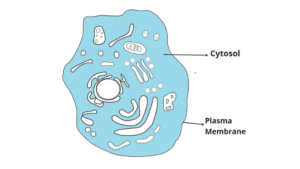
Know in one minute about cytosol
|
Introduction
Cytosol is the watery part of a cell, and if we take out all the different structures inside the cell, like the nucleus and cell organelles, what’s left is the cytosol. It’s like the remaining liquid part of the cell without all the other specific cellular structures.
In this article, we are going to talk about what is cytosol, where it is found, what are its components, its structure, and its significance in a cell.
Definition
“Cytosol” from Greek origin consists of “cyto” meaning “cell” and “sol” meaning “solution” or “fluid”. Cytosol is the main watery fluid inside the cell that is surrounded by the cell’s boundary and has a jelly-like consistency. It is also known as the aqueous phase or matrix of the cell.
Location of Cytosol
Present within the cytoplasm occupying the space between the nuclear envelope and plasma membrane.
It is found in all types of cells, and comprises about 20-25 % of the total protein content of the cell. And contains soluble proteins and enzymes.
In some cell types, the cytosol can be divided into two regions:
- The ectoplasm or cell cortex is a relatively non-granular, clear, and rigid layer of cytosol that lies at the periphery of the cell.
- The endoplasm, which is less viscous and more granular, forms the inner portion of the cytosol (1).
Features of Cytosol
- Colloidal in nature (mixture of water and components). Components like salts, and various types of organic molecules, including enzymes, nucleic acids, amino acids, nucleotides, vitamins, minerals, oxygen, and carbohydrates.
- Is the largest single compartment in most cells. And is filled with both large and small molecules, so closely packed that it exhibits gel-like behavior rather than a liquid solution.
- It is a critical location for many chemical reactions that are essential for the cell’s survival. For example, the cytosol is where the initial steps of nutrient molecule breakdown occur, and ribosomes within it produce the majority of the cell’s proteins.
- The cytosols of adjacent animal or plant cells often are connected by functionally similar but structurally different “bridges” called gap junctions in animals and plasmodesmata in plants (2).
Cytosol: Structure and Diagram

The structure of the cytosol can be divided into three main components
Water and ions
This organelle is primarily composed of water, which constitutes around 70% of its volume. Additionally, it contains a diverse range of ions including potassium, sodium, calcium, and magnesium that contribute to regulating the pH and osmotic balance of the cell.
Metabolites and macromolecules
It plays a critical role as the central location for metabolic processes, containing many metabolites and macromolecules. It consists of a wide range of small organic molecules, including glucose, amino acids, and nucleotides, which serve as essential building blocks for the synthesis of macromolecules.
Cytoskeleton
In eukaryotic cells, the cytosol is crisscrossed by long, fine filaments. A protein fiber network, referred to as the cytoskeleton, permeates the cytosol and provides the cell with mechanical support, shape, and structural organization (3).
Functions of Cytosol
- The cytosol is commonly referred to as a “soup” of cells. Because it functions as a liquid medium that houses all the organelles within eukaryotic cells.
- It is the site where the cytoskeleton is located which provides mechanical stability to cells.
- Contains dissolved nutrients and plays a crucial role in breaking down waste products.
- Assists in the movement of materials within the cell.
- Also contains free ribosomes that help in the production of proteins that reside in the cytosol (4).
Importance of Cytosol
- It acts as the distinction media. The cytosol and the internal spaces of organelles differ from each other and from the cell exterior in terms of acidity, ionic composition, and protein contents.
- Due to the presence of distinct environments within the cell, such as variations in salt composition compared to the external environment, the cell can be considered to have different “microclimates.”
- Another important aspect is that it houses “molecular machines” (molecules either natural or artificial that transcribe chemical energy into mechanical force and motion in the cell) (5).
Q&A
1. Where is cytosol found?
It is the liquid part of a cell. And present within the cytoplasm occupying the space between the nuclear envelope and plasma membrane.
2. Is cytosol the same as cytoplasm?
They are related but not the same. Cytoplasm is the entire region of a cell’s interior that is enclosed by the plasma membrane and includes all organelles, the cytosol, and the cytoskeleton. Thus, the cytosol is the fluid part of the cytoplasm
3. Where is the cytosol located in the mitochondria?
The cytosol is situated in the cytoplasm of the cell, outside the mitochondria. Mitochondria have a distinct internal compartment called the matrix, which is enclosed by a double membrane system comprising an outer membrane and an inner membrane.
4. What is cytosol and cytoskeleton?
It refers to the liquid part of the cytoplasm in a cell, whereas the cytoskeleton is a system of protein fibers that offer cell form, organization, and mechanical support.
Written By: Deva Singh
